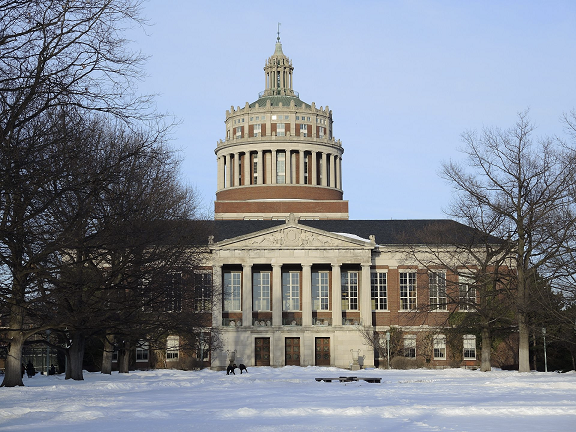
| River Campus | Rush Rhees Library |
 |
| Rush Rhees Library from Eastman Quadrangle. |
| Pictures of
Rush Rhees Library |
|||
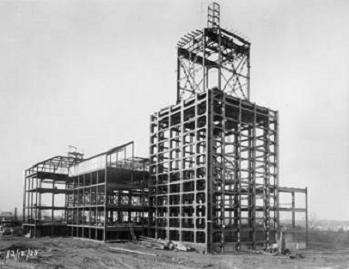 |
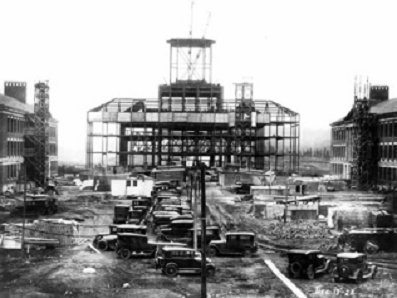 |
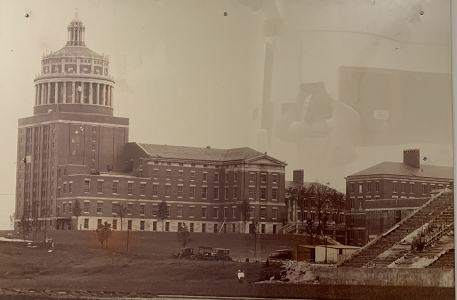 |
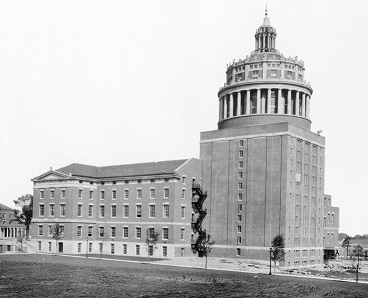 |
| December 18, 1928 |
1929 |
1930 |
June 30,
1930 |
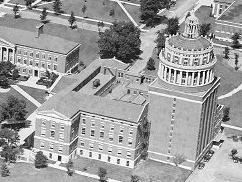
|
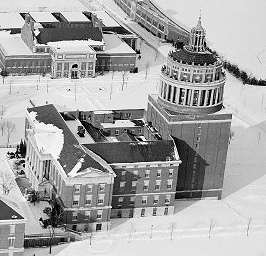 |
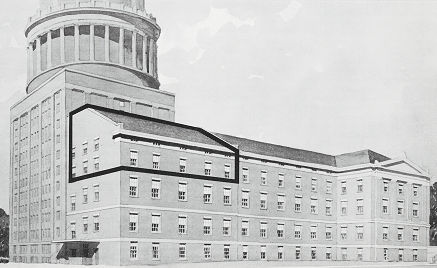 |
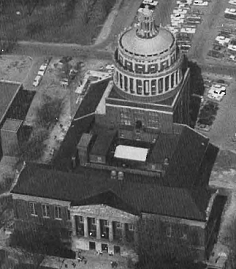 |
| 1930s |
1930s Winter | 1964 Addition (Outlined) |
Library with added floors on north side (1964) |
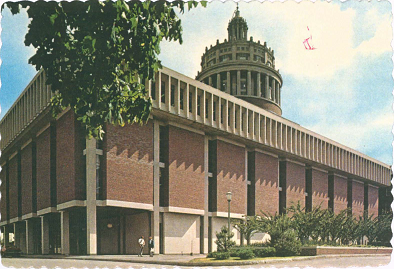 |
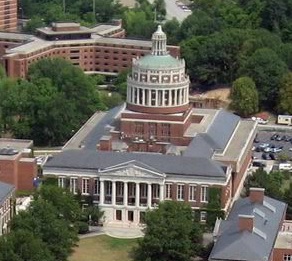 |
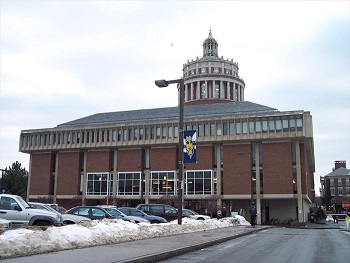 |
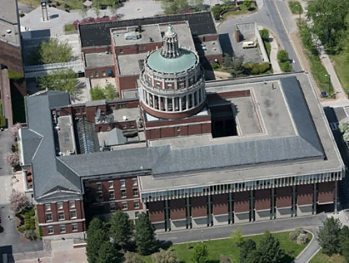 |
| 1970 new addition | 2004 | Library
addition with new windows installed with the Gleason Library project in 2007. |
2014 |
| Athena and Industry in the Rush Rhees Library | ||
| These two statues, which stand at the top of the Grand Staircase
in Rush Rhees Library, were designed by Phillip Merz (who also
designed much of the River Campus). The statues were carved at the
studio of A. A. Ardolino, who carved the Lincoln Memorial in
Washington, DC. (Ardolino also carved the figures in the pediment on
the façade of the Library.) The Statue of Industry is not based on
any figure of classical mythology, but has a cog near her left heel
and a wheel. She holds an oil lamp in her hand which according to
some was the second choice. The first design apparently showed her
holding a Kodak camera. This was deemed inappropriate, although Mr.
Eastman's funds were largely responsible for the building of the
River Campus. There is no evidence that the camera was anything more
than a design proposal; photographs from 1930 clearly show the oil
lamp. In the 1950s, the statues were deemed "unartistic." Newspaper articles from 1954 and 1957 note that the statues were offered free to anyone who could remove them without damaging the building. Then superintendent of buildings and grounds, James M. Young, was unsure of how that could be done. "When they were put in, there was a hoist to do it…It would take an engineering feat to get them out in one piece." Asked what would become of the statues if they found no takers, then-Library director John R. Russell, replied, "I guess they'll be there for the rest of time." |
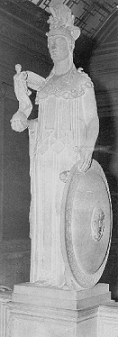
|
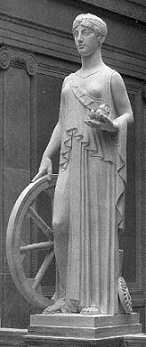
|
Rush Rhees library opened in October 1930 and was named for University President Rush Rhees, who was instrumental in the construction of the new River Campus for Men. Sibley Library on the Prince Street Campus continued to serve the College for Women until they moved to River Campus in 1955.
The teak front doors of Rush Rhees Library are carved with text composed by Professor John Rothwell Slater, head of the Department of English at the University of Rochester from 1908 to 1942.
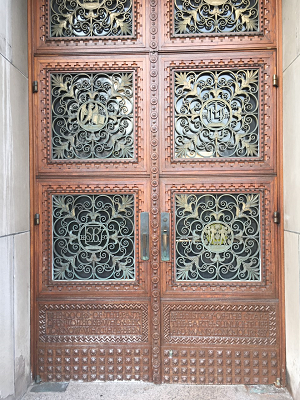 |
 |
 |
| Past |
Present |
Future |
| On the left : The Doors Of The Past Open To Those Who Seek to Know What Has Been...The History of the Stars, the Earth, Sunlight, Life and Man's Long Journey. | In the center: The Doors Of The Present Open To Those Who Seek To Know What Man Can Do...To Master His Fate By Science, Sustain His Spirit by Art, and Guide His Life By Wisdom. | To the right: The Doors Of The Future Open To Those Who Wonder What Life May Become...When Men are Free in Body and Soul, Loving All Beauty, Serving in Many Ways One God |
Always the most imposing feature of the building has been the library tower, nineteen stories, 186 feet high. Its upper portion is encircled by two graduated tiers of stone pillars, the lower of which constitutes an open colonnade, illuminated by almost 200 floodlights. An amusing story of these floodlights has been recorded:
"For the building of the River Campus there was a building committee of President Rush Rhees, Raymond N. Ball, university treasurer, and a faculty member. Ball got the idea that it would be attractive to floodlight the tower of the Library. He learned that it would cost $50,000 and raised the question with Rhees who said "No." In the summer of the year, however, Rhees went to Europe. While he was gone, the Library reached the completion stage and Ball made the decision to have the lights installed. After Rhees returned, Ball told him that he had floodlights installed in the tower. Rhees banged the desk, and said, "Sonny" (his customary name for Ball) "We decided against that" ... and he started to reprimand Ball. Ball, however, cut him off saying, "I refuse to be scolded until you see what the tower looks like. I am going to pick you up in my car tonight." This he did, having arranged with the support of the Buildings and Grounds people, to have the tower lighted. It was a beautiful fall evening and they drove to the campus along the west bank of the river and when they reached a point where the tower was fully visible and by chance also reflected from the surface of the river which was perfectly calm, Rhees said nothing. They drove across the river by the campus, down to the stadium and back up to in front of Eastman Quadrangle. President Rhees still said nothing. They finally stopped for a few minutes at the head of Eastman Quadrangle, and Rhees turned to Ball and said, "Sonny, that was a good idea and the right decision that we made to light the tower."*
The lantern atop the library’s signature dome was built to house the bells of the Hopeman Memorial Chime. Seventeen of these bells were given the University in 1930 by the children of Arendt Willem Hopeman, in memory of their father. In 1955 members of the Hopeman family contributed $25,000 for the purchase of two additional bells and their installation, and for an endowment for their maintenance. The chimes were replaced by the Hopeman Memorial Carillon in 1973, which was refurbished in 2017.
The circulation desk and card catalog was originally located in what is now the Great Hall. The book stacks were closed and patrons would submit a request and the staff would retrieve the items for check out. The original library design had 19 levels of stacks, of which 17 were in the stacks under the dome and 2 were on the ground floor area now occupied by the Art & Music Library. The original 1930 stack elevator was built with 17 landings and floor buttons to serve all of the proposed stacks. This elevator was rebuilt in 2018 and still has 17 buttons. Only 13 of the levels under the dome were built, the last five in 1955 including one constructed as a completely enclosed and fireproof strong room.to house the Thomas E. Dewey collection of official papers. A second stack elevator was also added in 1955, but only accessed the lower 12 levels (now G100 through G500M). The stacks were opened for browsing in 1955, but book thefts resulted in turnstiles being installed in 1959 to limit access to University faculty, staff and students. The use of turnstiles at first proved to be a traumatic experience for both patrons and staff, especially the custom of having students and faculty present their identification cards at the turnstiles to gain access to the stacks. The circulation desk moved to the first floor in 1969 and the old room became known as the Great Hall. The room was renovated in 2000 on the occasion of the 150th anniversary of the University through the generosity of the Gleason Foundation.
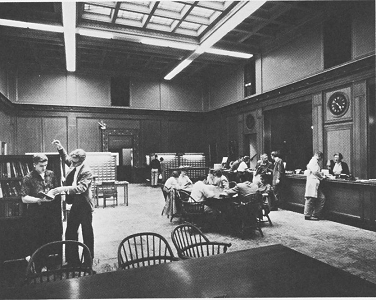 |
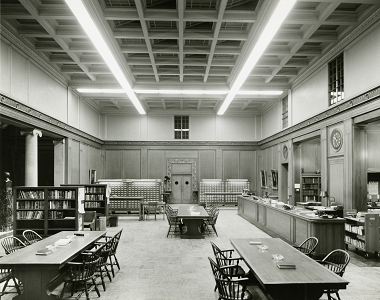 |
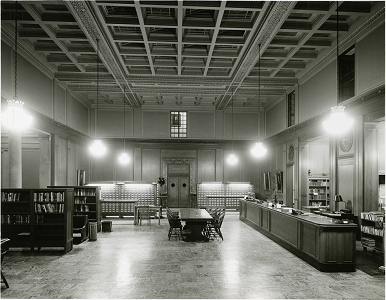 |
| 1930 Circulation Desk and Card Catalogs (click on image for larger picture) | ||
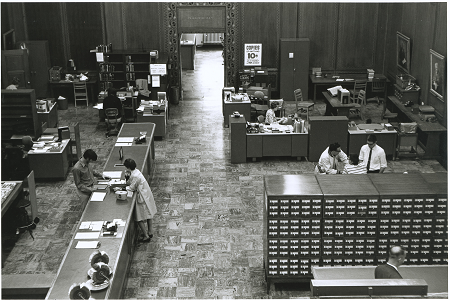 |
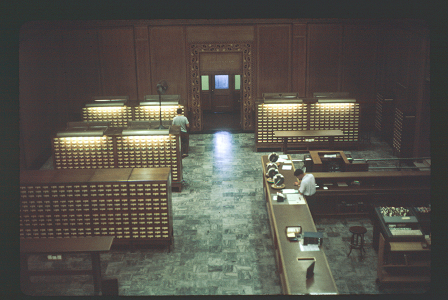 |
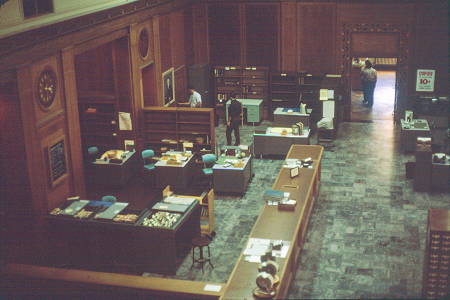 |
| Circulation Desk after installation of turnstiles in 1959 (click on image for larger picture) | ||
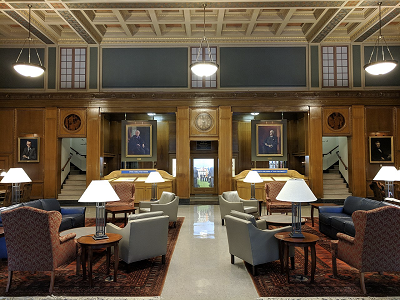 |
| Great Hall |
The circulation area on the first floor was renovated in 2016 to become Evans Lam Square.
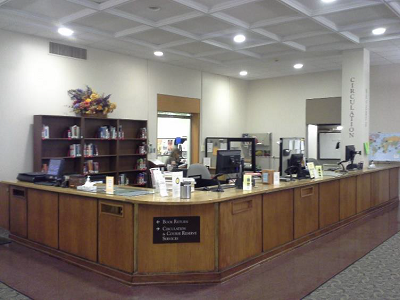 |
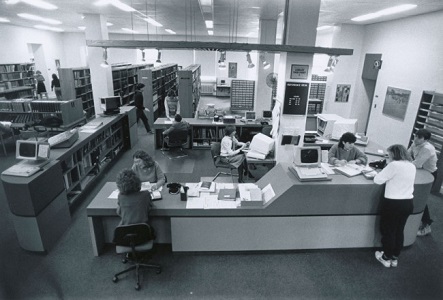 |
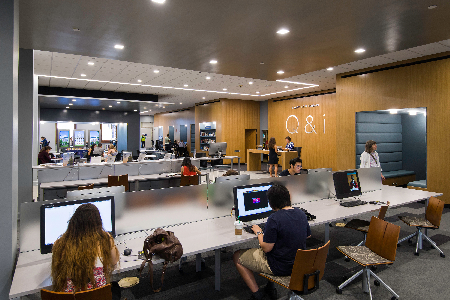 |
| Circulation Desk 1970-2016 | Reference Desk | Evans Lam Square |
A reserve reading room was located in what is now the Hawkins-Carlson Room, reserve books were kept in an adjacent room that is now part of Lam Square. A new reserve reading room opened in the 1969 addition, and became the Computing and Reserve Library (CARL) in 1988 when the Micro Information Center moved from Taylor Hall. In 1991 it was renamed again as the Computing Library and Resource Center (CLARC). The space is now occupied by the iZone, which opened in 2018.
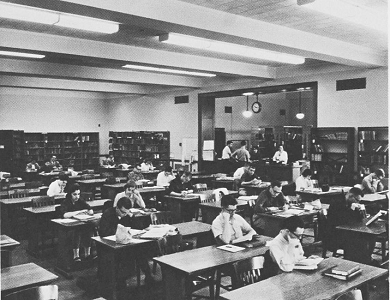 |
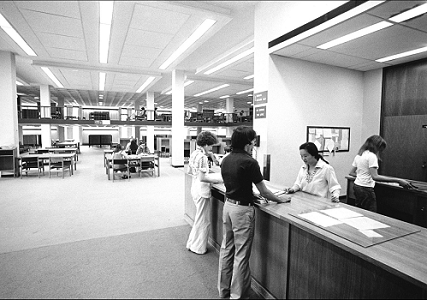 |
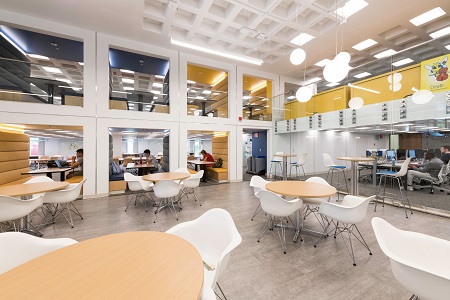 |
| 1930 Reserve Reading Room | 1970 Reserve Reading Room | iZone |
In September, 1943, a cafeteria was opened in the library basement in the area now occupied by the Education Library. The cafeteria advertised breakfast for 30 cents, lunch for 50 cents, and dinner for 75 cents. It also appealed for the business of special dinners and banquets. Much to the relief of the librarians who were grim about the cooking smells and the sight of cockroaches and rats who were attracted to the building, the cafeteria was closed in November, 1944.
An anonymous donor funded a Microcard publishing operation in the library that operated from 1953 to 1968, when it was transferred to University Editions, Inc. The material to be printed is reduced 18 or 20 times and a positive photographic print is reproduced on a 3 x 5 card. Thus a 300-page book can be printed on 3 Microcards. One small card drawer can hold 40 to 50 volumes. The cards can be read through a reader which enlarges a page 24 times. This technology did not prove to work in the long run as the readers (and a few reader/printers) were maintenance intensive and the cards could not be easily transferred to other media. Most Microcard publication were later published on microfilm, and many have been converted to more easily accessible electronic formats.
A public elevator was included in the original building design but was not installed until 1963. The 1969 expansion added four new elevators.
Library collections kept increasing at a rapid rate and in 1953 the University engaged Keyes D. Metcalf, former librarian of Harvard University and a recognized expert on university library buildings, to consult on planning the expansion of Rush Rhees library. Metcalf's report recommended immediate steps to reclaim library space then used for non-library purposes and to construct an additional six levels of stacks inside the Rush Rhees dome. Further investigation by architects revealed changes to building codes since the library was built made this impossible. Another two stacks house the Art and Music Library collections on the ground floor.
The north side of the old stacks had two floors, and two additional floors were added to these in 1964 to house the presidential offices, but the space was instead used by the library. The additional space was used by the library and was sorely needed.
The bookstore was moved from the basement of the library to the enlarged Men's Dining Center in 1963. A new addition was opened in 1969 and dedicated in April 1970, doubling the library's space.
An electronic book theft detection system was installed in 1985 to reduce losses. Also in 1985 the first floor was changed to ground, the second floor became the first, and so on.
The University libraries installed a Geac 8000 electronic card catalog that began operating in 1985 and was named Chester, which was short for Rochester and also evoked Chester Dewey and Chester Carlson. The system was upgraded to a Geac 9000 in 1988, but was obsolete by 1995 and was replaced by the Voyager catalog in January 1997. This was replaced by Alma on July 30, 2019, and then upgraded to Primo on July 12, 2021, which is known as DiscoverUR.
A McDonald's french fry vending machine was installed in the tunnel by the library entrance in March 2003 and was removed about a month later after receiving mixed reviews.
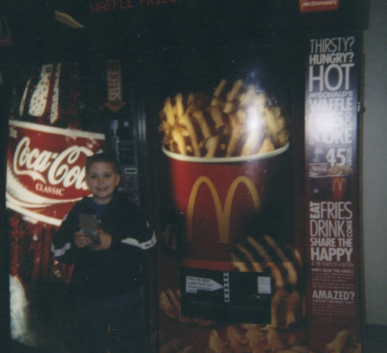 |
| French Fry Vending Machine in Rush Rhees tunnel, 2003 |
The interior of the library has been extensively renovated and is very popular with students.
References
1926 "Gilchrist
Seeks to Compromise Between Rival Factions in Plans for New Library,"
The Campus, May 14, 1926, Page 3.
1930 "Rochester's Library of the Near Future," Rochester Review 8(3)66-70 (February-March 1930)
1930 "Name
of Rush Rhees Given to New Library," Rochester Review
8(5):131-132 (June-July 1930)
The new River Campus is acquiring further personality. Save for the few
buildings christened at the beginning of operations, the different college
structures have been thus br merely nameless buildings, designated by
common nouns. Now they are to achieve the dignity of proper names,
representing something more than mas es of brick and stone.
Foremost of these is the commanding structure at the head of the main
quadrangle, which is to be known as the Rush Rhees Library. Against the
sincere protest of President Rhees himself, the Board of Trustees recently
voted to give his name to the new library, and in that action it may rest
assured of the hearty accord of the alumni, faculty and general public.
The reasons back of this decision seem too obvious to call for
delineation. Back in 1900 Rush Rhees came from a professorial chair at
Newton Theological Institute to assume the reins of the small,
conservative liberal arts college which was then the University of
Rochester. During the thirty intervening years of his sane but progressive
guidance that small college has extended the scope of its influence,
slowly but steadily, establishing separate colleges for men and women, an
extension division and a summer session, instituting courses in mechanical
and chemical engineering, in vital economics, in optometry and applied
optics; then, through the generous interest of George Eastman, coming on
with a rush to assume the role of a university in fact, as well as in
name, by the establishment of the new schools of music and medicine.
And now this great expansion movement under his leadership is about to be
climaxed by the material strengthening of the old college in the
dedication of the new River Campus of the College for Men and the
rededication of the old campus to the purposes of the College for Women.
It seems wholly appropriate, therefore, that the dominant architectural
and structural feature of the new campus should be honored with the name
of the dominant personality behind the entire development.
1930 The Schiff Photographs of the River Campus | Rush Rhees Library | Interior Images |
1931 "The Rush Rhees Library at the University of Rochester," by Donald R. Gilchrist, The Library Journal 56:332-336 (April 15, 1931)
1934 "New Catalogue Cards Could Pave Path from Library to Lakeshore," The Campus, May 11, 1934, Page 1.
1938 "Work
Rooms in College and University Libraries," by Edna R. Hanley, American
School and University 10:339-344 (1938)
Page 340: Rush Rhees Library
1940 "More Library Units
Open at Rochester; University Adds Three Levels For 110,000 Volumes," The
New York Times, December 15, 1940, Page 69.
Rochester, N.Y., Dec. 14- Aware that the heart of a university is its
library, the University of Rochester celebrated today the opening of three
additional book levels in Rush Rhees Library on the campus of the College
for Men, thus increasing the shelving space in this million-dollar
building by more than 110,000 volumes.
The highest book tower in the world, Rush Rhees Library has room for a
million volumes, but only five of its nineteen levels were fitted with
shelves when the building was opened in 1930. About 205,000 of the 365,000
volumes in the university's book collections are now in this building. The
remainder are housed at the Eastman School of Music, the College for
Women, the School of Medicine and Dentistry and in various departmental
libraries.
Opening of three more levels also increased the number of private cubicles
:for graduate students and seniors by eighteen and provided two additional
typing rooms.
A locked section has been fenced off on the fifth level for storing books
restricted in circulation because of their cost or the nature of their
subject matter. Single copies of university theses and prize essays from
various undergraduate competitions will also be kept in the looked
section.
1954 "Library Stacks Climb From Eight to Twelve," Campus Times, October 1, 1954, Page 2.
1954 "2 'Classic' Statues at UR 'Flunk' Art Board's Test," by Kurt Rohde, Democrat and Chronicle, October 31, 1954, Page 5B.
1955 "UR Starts Moving Books From Women's Campus," Democrat and Chronicle, April 8, 1955, Page 29.
1955 "UR
Library Adds 7 Stack Levels," Democrat and Chronicle, April
12, 1955, Page 22.
Seven more stack levels have been added in Rush Rhees Library at the River
Campus of the University of Rochester to provide for the approximately
100,000 books being moved from the Women's College library at the Prince
Street Campus. The move is part of the merger of men's and women's
campuses.
Five of the new stacks are in the tower of Rush Rhees comprising floors 9
through 13. The 13th floor will house the Thomas E. Dewey collection of
official papers, and is being constructed as a completely enclosed and
fireproof strong room. Two of the new stack levels nave been put up in the
basement of Rush Rhees, in the central part of the building in what was
formerly a storeroom.
1955 "Moving
Nears Close; Began Last April 7," Campus Times, November 15,
1955, Page 2.
Material needed by the fine arts classes of the Arts College was moved
from Memorial Art Gallery into space vacated by the AFROTC unit in Rush
Rhee Library. In Harkness Hall, the NROTC offices had to move into
other quarters in that building to make room for the AFROTC staff which
was shifted from the basement of Rush Rhees.
1957 "Unloved
Ladies," by Brian Sullivan, Democrat and Chronicle, June 1,
1957, Page 7.
University Wants to Give Heave-Ho to Pair. The University of Rochester is
willing to give away these two statues now in Rush Rhees Library if anyone
can get them out without doing any damage to the building.
1958 "The Library heart of the University," Rochester Review 20(2):3-10 (November 1958)
1958 "Microprint Center," Rochester Review 20(2):10 (November 1958)
1959 "Fall Coffee Hours Planned; Library to Install Turnstiles," Campus Times, April 17, 1959, Page 4.
1959 "Turnstiles installed to curb book losses," Campus Times, September 18, 1959, Page 8
1961 "The
Face on the Wall," Democrat and Chronicle, April 26, 1961,
Page 17.
At the University of Rochester's Rush Rhees Library a turnstile was
installed leading into the stacks was installed in the past year. Students
and faculty members must present their identification cards to the student
on duty before being permitted access to the stacks. (Educational note: a
stack is a library structure, one or more stories high, of shelves and
narrow aisles for compact storage of books. In the UR stacks are thousands
upon thousands of volumes. Which is probably where the expression
"well-stacked comes from.) Dr. Dexter Perkins, Watson professor emeritus
of history and former chairman of the UR's history department, visited the
library the other day for the first time in more than a year. As he
started into the stacks, he was stopped at the turnstile border by the
student who requested proper identification. Dr. Perkins searched his
pockets fruitlessly for something, anything that would prove who he was.
His pockets were bare; he was as anonymous, at the moment, as the first
mate on Columbus' flagship.
Amused by the impasse, Dr. Perkins finally hit upon a solution. He
directed the student's attention to a portrait hanging on the library wall
– a portrait of the historian himself, presented to him by the university
last year.
The student agreed that it constituted sufficient identification.
1961 "Open Record Room at
Rush Rhees," University Record 1(2):3 (July 1961)
Nearly 200 music records have been added to the library of the new
phonograph room at Rush Rhees Library for the use of employees, faculty
and students of the University.
Eight new players have been purchased for the redecorated room which is
entered through the Welles-Brown Room. Upon presenting his identification
card, anyone may listen to a record in the room or borrow any two records
or one album for home use for a seven-day period.
There is a fine of 25c per day for overdue records and the borrower must
replace any record damaged by careless use. A wide range of tastes is
represented in the new collection with a balance of classical, popular,
instrumental and choral records. Poetry and drama records previously made
up the library collection.
Suggestions for new music and speech records by borrowers are welcomed by
the library staff.
1961 "Micropublication
Grows," University Record 1(3):2 (August 1961)
In 1953 an anonymous grant of $45,000 was given to the University for
publishing. The subscriber response has been so encouraging that although
it was believed that the grant would last three years, enough funds have
been earned to turn back into the service to enable publication to
continue.
The material to be printed is reduced 18 or 20 times and a positive
photographic print reproduced on a 3 x 5 card. Thus a 300-page book can be
printed on 3 Microcards. One small card drawer can hold 40 to 50
volumes. The cards can be read through a reader which enlarges a
page 24 times. It is obvious what this means in the conservation of space.
1961 "Microtexts Offer Rare Documents," Campus Times, December 16, 1961, Page 8.
1963 University
Record 3(3):2 (March 1963)
The new passenger elevator in Rush Rhees Library has just about reached
completion, and should be “open for business” shortly.
1963 "Library
Will Triple Capacity To Serve Growing University," Campus Times,
March 8, 1963, Page 2.
New stacks in Rush Rhees can no longer be added above the existing
fourteenth level. The University originally built the stacks during as a
self-supporting structure, with the floors of the levels less last than a
quarter of an inch thick and the entire structure supported by the earth.
The present building code does last not permit such structures to be
built.
New Type Construction
Any new stack levels must have concrete floors six inches thick. Because
of construction difficulties, it would not be feasible to build concrete
floors in the existing tower. Construction will probably take place in
back of Rush Rhees.
1963 "The
Only Way to Go is Up," Rochester Review 25(4):34
(March-April 1963)
The space problem on the River Campus will be alleviated to some degree
with the addition of two stories to the south wing of the Men's Dining
Center. The some 20,000 square feet of floor space gained will house an
expanded Faculty Club, office space for the Placement Office, and nine
meeting and seminar rooms for student and faculty use.
When the addition is completed next winter, the book store will be moved
to the present area occupied by the Faculty Club, and the space in Rush
Rhees Library vacated by the book store in turn will be remodeled to
provide expanded library facilities for the College of Education and the
College of Business Administration.
1964 "Wallis Delays Move
To Library, Cites Space Needs," University Record 4(5):1 (May
1964)
President W. Allen Wallis announced earlier this month that because of the
University’s urgent need for additional library space, he will postpone
his scheduled move from the Administration Building to Rush Rhees Library
“until completion of the University’s projected major addition to the
Library.”
President Wallis said his decision to keep the offices of the president,
the provost and the associate provost in the Administration Building for
the present will free the two floors currently under construction at Rush
Rhees Library for use by the Library’s cataloguing and acquisition
departments.
1964 "The Lifeblood of Learning - A Million Dollar Enterprise," University Record 4(9):4-5 (October 1964)
1965 "$80 Million Expansion Projected by U. of R.," Democrat and Chronicle, April 30, 1965, Page 1. | Part 2 |
1965 "St.Louis Firm to Design UR's Library Addition," Democrat and Chronicle, May 17, 1965, page 32
1965 "Library Schedules Spring Ceremonies for Addition," Campus Times, September 24, 1965, Page 2.
1965 "$1.27 Million Grant Given UR Library," Democrat and Chronicle, November 23, 1965, Page 13.
1965 "U.S. Gives UR $
Million Grant for Library," University Record 5(11):3 (December
1965)
The University of Rochester has received a $1,275,065 grant from the U. S.
Office of Education for the expansion of Rush Rhees Library.
The grant will be used toward the construction of a major addition to the
library and remodeling of the existing building. The project will more
than double the library’s space.
The library expansion program is the largest single commitment for the
River Campus in the $38 Million Campaign announced last spring. Estimated
cost is about $5.8 million, of which $4.5 million is being sought from
private sources and the balance from government agencies.
The expanded library will provide seating for 1,500 undergraduates, study
cubicles for 570 graduate students, and studies for 125 faculty members.
In addition, the enlarged facilities will include rooms for typing, an
audiovisual center, improved facilities for rare book collections,
increased space for staff operations, and additional stack space.
It is expected that construction of the new wing — the first major
physical expansion of the library since 1930 — will begin next summer. The
addition is scheduled for completion by summer, 1968, and renovation of
the existing building for later that year.
1966 "Library
Expansion," Rochester Review 28(2):23 (Winter 1966)
The long-sought expansion of Rush Rhees Library has moved a step closer to
reality with the receipt of a $1,275,065 grant from the U.S. Office of
Education.
The expansion program – including construction of a major addition and
remodeling of the existing building – building accounts for the large st
single commitment for the River Campus in the $38 Million Campaign.
The project, which will more than double the library's space, will cost
about $5.8 million; of this amount, $4.5 million is being sought from
private sources through the campaign and the remainder from government
agencies.
1965 "$5.8 Million to Double UR Library," Democrat and Chronicle, May 18, 1966, Page 17.
1966 "Tomorrow
On The Campus," Democrat and Chronicle, September 25, 1966,
Page 1M.
Addition to Rush Rhees Library and New Campus Center
1966 "Rush Rhees Expansion Out for Bids; Dorm Construction Starts in January," Campus Times, November 11, 1966, Page 1 | Part 2 |
1967 "Colleges
Cram for Big Expansions," Democrat and Chronicle, January
22, 1967, Page 8S.
Projects Completed during 1966 at the U. of R. included the nuclear
structure laboratory, $1.7 million; a University Medical Center addition
for the department of radiation biology and biophysics, $2.8 million. In
progress were a medical center wing containing research facilities and
quarters for animals used in research, $4.5 million; a modernization and
expansion of the heating plant, $5 million. Both are scheduled for
completion this year. Planned to start this year are: expansion of Rush
Rhees Library with a new wing, $6.4 million; six-floor space science
center, $1.5 million; six four-story undergraduate dormitories, $4.4
million; a chemistry-biology building, $11.5 million; six-story education
wing at the medical center, $10 million; temporary expansion of emergency
department at Strong Memorial Hospital, $500,000.
1967 "New
Quarters for Visual Science Center," Rochester Review
29(3):23 (Spring 1967)
New facilities for the three-year-old Center for Visual Science opened
recently, marking the beginning of an expanded program of teaching and
research in that field at Rochester. The new quarters, on the fifth floor
of Rush Rhees Library, include laboratories for graduate students, a
seminar room, and office space.
Currently 14 faculty members and 20 graduate students, research
associates, and post-doctoral fellows are participating in the Center's
activities. One of several interdisciplinary units on campus, the Center
has no full-time faculty of its own but draws upon participating members
from departments whose activities include research in visual science -
psychology, optics, physiology, brain research, electrical engineering,
ophthalmology, and anatomy.
1967 "Yule
Prank," Democrat and Chronicle, December 19, 1967, Page 6B.
University of Rochester's 186-foot high tower at Rush Rhecs Library
sported its own bit of seasonal greenery yesterday as pranksters took
dangerous chance and negotiated their way to plant a Christmas tree.
University officials said the appearance of the tree probably coincided
with reports that locks in the doors and elevators
1969 "New
Library Additions Bewilder Students," Campus Times, October
10, 1969, Page 3.
This year the library has adopted an inter-library loan system. This
organization enables a graduate student or faculty member to borrow books
which are not available in the university library from other libraries
located in Wayne, Monroe, Ontario, Wyoming, and Livingston counties. In
order for an undergraduate to obtain such books, he must obtain a
signature of approval from a faculty member.
1970 "Open Stack System Increases Book Losses," Campus Times, January 9, 1970, Page 3.
1970 "Ceremonies Mark Dedication of 'New' UR Library," Campus Times, April 28, 1970, Pages 1,2.
1970 "The
History of the University of Rochester Libraries," by Catherine D.
Hayes, The University of Rochester Library Bulletin 25(3):59-122
(Spring 1970) | also here
|
| 9. Planning a New Library
| 10. The War Years and a
New Librarian | 11. Expansion
of the Fifties | 12. Rare
Books and Manuscripts | 13. Enter
the Nineteen Sixties | 17. Building
Data (1970) |
1973 "New Ring in the
Air," University Record, February 1973, Page 7
UR's new Hopeman Memorial Carillon was dedicated in a special public
concert by Dutch carillonneur Arie Abbenes on Dec. 9.
1976 "Keyboards help keep
expenses down for UR libraries, University Record 16(2):1,7
(February-March 1976)
The key to this efficiency is a cathode ray tube (CRT) terminal that links
the UR's libraries with a computerized data base at the Ohio College
Library Center (OCLC). The keyboard of this terminal needs be used only
once to enter cards for each new book, and there are at least three
different ways it can search the data base—by author, by title, or by
Library of Congress card number.
1977 History
of the University of Rochester, 1850-1962, by Arthur J.
May. Expanded edition with notes
Chapter 22, Oak Hill Becomes River Campus
In finished form, the monumental library--an epic in brick and
stone-dominated the campus panorama, and at the rear space was available
for future expansion. Recommendations by some University officers that the
library should stand on the south side of the quadrangle, in the direction
of the Medical School, were frustrated by the architects' conception of
what would be most impressive and speak of strength and virility.
Responsibility for the interior detail rested with the young, energetic
University librarian, Donald B. Gilchrist, who learned much of value on
visitations to other university centers and who chose the experienced
James T. Gerould of Princeton University as consultant.
Pressure by the trustees virtually forced Rush Rhees to allow his name to
be affixed to the Library. On order of the board, too, tribute was on the
Oak Hill project paid to architects, builders, and workmen in an
inscription on the south wall of the library foyer, while close-by the
names of the thousands of subscribers to and the campaign personnel of the
1924 Greater University drive were recorded in a glass-encased volume.
The imposing round tower of the Library soared to nineteen stories,
reaching a height of 186 feet. At the summit a stone lantern held a chime
of seventeen bells, played from a room on the nineteenth level, Professor
Slater serving as the pioneer bellman.
Slater also composed or selected inscriptions, epigrams, medallions, and
names to adorn several sections of the Library. A faculty committee after
no little travail picked the twelve immortal intellectuals whose names
stood on a frieze across the facade. Rising above the main entrance was a
classic portico of six Doric columns, topped by a pediment with statues of
four humans and two lions centered around the seal of the University.
Still higher was a circular open colonnade leading to the stone lantern
and thence to the summit. Against the expressed wishes of Rhees--though to
his unfeigned delight--floodlights were installed to illuminate the upper
portion of the huge structure. For the facade Indiana limestone was used
extensively. Granite balustrades extended from the Library to the adjacent
academic buildings.
Sets of double doors made of teakwood opened into the foyer of the
Library. They held glass panels, protected by bronze grilles, and
incorporated near the bottom the marks of pioneer printers. The foyer
itself had a mosaic marble floor, and walls of polished Indiana limestone,
colonnaded with fluted stone pillars. Set between the pillars were cases
in which to display books, manuscripts and the like; and, above the cases
were portrait medallions of the muses and illustrations of the varied
methods of recording human thought. Lintels of carved stone over doors on
either side of the foyer bore likenesses of the goddesses of wisdom and
memory.
A doorway to the south admitted to an austere reserve reading room while
its companion on the north opened into the prototype of a private club.
Oak panelled walls, a painted glass window in an alcove, a fireplace, and
comfortable chairs and settees were an invitation to relaxed reading. A
line of Cicero stood over the fireplace, "In Secundis Voluptas In Adversis
Perfugium"--"in success a joy, in adversity a shelter. " Called originally
a browsing (which chance undergraduates interpreted as "drowsing") room,
it was the gift of two trustees, Francis R. Welles, 1875, and Charles A.
Brown, 1879, and in time it was renamed in their memory.
Off a hall at the east end of the ground level, a Treasure Room, furnished
by Trustee Edward G. Miner, formed a sanctuary for rare books, precious
documents, and original manuscripts, the most prized of them secure in a
large vault. At the opposite side, space that had initially been thought
of as a second reserve room eventually became the quarters of the
University archives, regional history resources, and allied holdings. On
the northeast corner of the first floor was a lecture room large enough to
accommodate 150 auditors.
Solid stone balustrades, in which marks of old-time printers were cut,
lined two grand stairways proceeding to the second floor--"the working"
area of the Library. A tribute on the wall along the south staircase
directed attention to the Library chime donated by the Hopeman family. At
the head of the stairs two stone statues symbolized knowledge and industry
(originally, the latter held a camera in her hand, but good taste dictated
its removal). The hall on this level opened into the book catalogues and
the loan desk, and to the south was the periodical room, each publication
in a dust-proof box of its own. Library administrative offices and the
cataloguing department occupied the northern sector of the floor. A
spacious reading room was laid out on the west side and ringed around with
open shelves holding major works of reference; names of eminent thinkers
and authors from Moses to Madam Curie stood over the cases. Medallions of
famous writers and choice epigrams filled three panels at either end of
this handsomely proportioned hall. Off to the south was the
bibliographical room, and to the north an area where readers might smoke
if they chose.
Small seminar and staff rooms were placed on the third level, while the
fourth floor and the basement were largely vacant, except for newspapers
stored in the latter. On or beside walls throughout the edifice, portraits
or busts of Presidents and of other notable personalities in the
University saga were set.
It was estimated that the Library stacks could accommodate 676,000
volumes, or with additional shelving as many as one million. At first only
five of the nineteen levels were opened, and approximately 136,000 titles
were brought from the Prince Street Campus. An elevator ascended to the
nineteenth level, and automatic conveyor belts, never much used, were
installed to transfer books to and from the stacks to the loan desk. Costs
of the building and equipment substantially exceeded preliminary
calculations. A highly important decision was taken to classify all
University holdings on the Library of Congress system, which necessitated
recataloguing the volumes acquired over the decades by the College
library.
Chapter 30, Education for Victory
Upon the coming of the V-12 an improvised lunchroom for civilians and
teachers was set up in the Fauver Stadium, ladies of the faculty
volunteering as waitresses at what resembled a picnic. Soon, however, the
kitchen equipment of the Faculty Club was transferred to the basement of
Rhees Library and a cafeteria there served meals on weekdays. It was
possible for faculty men to meet colleagues at "The Greasy Spoon," though
"only those blessed with operatic vocal chords" could be heard above the
noise; before long, a room in the library was set aside as a faculty
rendezvous for part of each day. Hosannas greeted the news that after
October, 1944, Todd Union would have space to feed teachers and civilian
students.
Chapter 33, The First Century Ends
Thanks to a subsidy from the New York State government, extensive
alterations were made (1946) in Todd Union, the former bookstore, for
instance, being converted into a bakeshop (the bookstore found a temporary
haven in the basement of Rhees Library) and subsequently a new kitchen and
a cafeteria were provided.
Chapter 37, In Pursuit of Excellence
Governmental agencies paid (1961) for the lowering of the smokestack on
the University power plant, which stood in the flight path to and from the
Rochester airport, and for installation of safety lighting atop Rhees
Library tower. Space rights accorded to the Federal Aviation Agency
prohibited construction on the River Campus that might possibly be an
obstacle to planes.
1978 "Library uses classic system," Campus Times, February 3, 1978, Page 1 | Part 2 |
1978 "University of Rochester Library," Encyclopedia of Library and Information Science 25:445-470
1980 "New Home for Old Sculptures," Democrat and Chronicle, September 15, 1980, Page 1C. | part 2 |
1980 "Wyatt seeks library computerization," Campus Times, September 16, 1980, Page 1 | Part 2 |
1980 “Four restored statues unveiled,” Campus Times, October 7, 1980, Page 8. .
1980 "The
Great 'Removal Project' Part II: A Dream Attained," by Betsy
Brayer," Rochester Review 43(2):10-15 (Winter 1980-81)
The names on the frieze on the front of the library were "specially
arranged." Those on the west, "Aristotle, Augustine, Descartes, Newton,
and Kant, are scientists, realistic in outlook." On the same side is Dr.
John Slater's inscription, "Here is the history of human ignorance . . .
recorded by human intelligence for the admonition of wiser ages still to
come." On the east are "Plato, Virgil, Dante, Shakespeare, and Goethe,
representing the spiritual, idealistic side of life," along with Slater's
words, "Here is the history of man's hunger for truth." Four centuries of
printers' marks were wrought in iron for the main doors and carved in
Indiana limestone along the balustrades of the grand stairways inside.
The quartet then met with Dr. Rhees, who critiqued everything from the
height of the ceilings and locations of the stairs to the shape of the
lecture room and the advisability of locating the browsing room in Todd
Union. The architects wanted a passenger elevator; librarian Gilchrist did
not; arbiter Rhees said, "make provision but do not install."
1983 "Library structure forces moving of books," Campus Times, October 3, 1983, Page 1.
1983 "Libraries
to get new computer system," Campus Times, October 17, 1983,
Page 1 | Part
2 |
The UR will purchase the system from GEAC of Toronto.
1984 "Automated
Library," Rochester Review 46(2):31 (Winter 1984)
The customer enters.
He steps up to a computer terminal and, with a few deft strokes,
determines the location of the desired goods.
Information in hand, he speeds past shelf after shelf, knowing just where
to look.
Finally, goods stashed securely under the left arm, he strides with
confidence toward the computerized checkout.
It's time to start that term paper.
The scenario reads more like a trip to Rochester's largest supermarket
than a research visit to a University library, but finding a book will be
just that easy after a conversion process involving the library's nearly
two million volumes and eight million catalog entries.
With the system in place, says library director James F. Wyatt, patrons
will be able to search the library system's holdings from terminals
located in offices, labs, or the library itself. They will retrieve their
books from library shelves, and staff members will release them after
linking a bar code in the book with the one on the patron's ID card.
The whole system - on-line "card" catalog and electronic checkout - is
scheduled for completion in the spring of 1985, Wyatt says, but the first
online catalogs will start appearing in science libraries in the fall.
Before movers cart away the old catalogs, staff members must transfer
their contents to the library's own data base. Two years have passed since
librarians started that process, and about 100,000 records have been
transferred. By the fall, Wyatt expects to have four or five times that
number on line.
The library began the conversion using grants totaling about $370,000 from
the estate of Fanny Knapp Allen. (Mrs. Allen was the wife of Wheeler
D. Allen' 12, president of the former C. P. Ford Co., a local shoe
manufacturer.) The library is engaged in an appeal for additional funds to
complete the automation project.
The automation project, Wyatt says, was first proposed in 1980. This past
summer, project managers selected their computer system, one made by GEAC,
Inc. of Toronto.
"GEAC's software is tailored to our type of needs," Wyatt notes. The
system will allow speedier and more comprehensive searching of research
material, and often will point out material that would have been
overlooked in a manual search.
In addition, he says, the system will improve the University's access to
other research libraries across the state and beyond.
Once workers complete the catalog conversion, they will place a coded
circulation strip in each book in a process known as "linking." Linking,
library workers say, will effect the first complete holdings inventory in
at least fifty years, and will make future inventories far easier.
The complete automation project will be costly, Wyatt observes, but the
final price has yet to be determined. "We're not sure exactly how big that
data base is going to be-that's really the key to how much it's going to
cost."
Wyatt and his staff are exploring still further uses for the new system,
including automating acquisition of new material. For now, though, they
have their hands full.
"In 1980 we were way behind," Wyatt says. "We have moved up through the
pack and now are slightly ahead, particularly when compared to other
libraries our size."
By the time library assistant Margaret Feldman and her colleagues are
finished with the conversion process, a streamlined system of "on-line"
cataloging will replace the familiar ranks of card catalogs that record
the UR library collection of two million-plus volumes.
1985 "Pew Trust gives
$500,000 to automate UR libraries," Currents, March 1, 1985, Page
2.
The grant will support the installation of an on-line public catalog and
an automated circulation system, leading ultimately to automated systems
for managing acquisitions, periodicals and administrative bookkeeping.
Within a few weeks, patrons will begin using computer terminals to find
library materials.
The computers will search for items faster and more thoroughly than a
person could using the 4 million cards in the public catalog. Within the
next few years, the online catalog will replace the card catalog entirely.
When the first of the Rochester systems goes on-line this spring, the
University’s libraries will become one of the few in the nation to have an
on-line catalog for patrons.
1985 "Library
reference system to be computerized," Campus Times, March 4,
1985, Page 1
Beginning in mid-April UR libraries will install computer terminals to
replace the existing card catalog reference system.
The 120 terminals were purchased from the Toronto based GEAC corporation
for an estimated cost of $400,000. This figure includes the
"software", or programs that will run the computer.
The system will eventually be hooked up to the UR mainframe computer, so
that any personal computer connected to the mainframe will have access to
the system.
1985 "Chester combs every
cranny searching for your books," Currents, June 14, 1985, Page 2.
Next time you’re passing through Rush Rhees Library, you should make a
point of meeting Chester.
I did last week, and can honestly say he was much easier to get to know
than I’d ever have expected.
Chester, for those of you who haven’t yet met him, is the on-line catalog
system now in use on a limited basis in the Rush Rhees, Edward G. Miner,
and physics libraries, and who will arrive soon at other University
libraries.
He’s the program and database connected to the video terminals you’ll see
near the reference desks in these libraries, and his memory contains
information bn most books and journals received by the River Campus
libraries and the Edward G. Miner library since 1974, as well as most
materials received by the Sibley Music Library since 1982.
How did Chester get his name, you wonder? “It’s a short form of
Rochester,” Chester’s project director Ray Metz explains. It’s a name that
went over big with other University library staffers because it reminded
them of Chester Dewey, one of the founders and first faculty members of
the University, for whom Dewey Hall is named, and also was reminiscent of
Chester Carlson, who invented the xerographic copying process and who’s
the namesake of the River Campus library.
Chester is replacing the card catalog. Instead of looking up materials by
opening one of those long, narrow drawers crammed with hundreds of cards,
you sit down in front of Chester’s screen, punch in a few commands on his
keyboard, and watch as he reveals the library’s holdings in your area of
interest. Push the “help” key, and Chester thoughtfully gives you
instructions on how to proceed with your search.
The day that I stopped by, I was doing a little research on Native
American writers, so I asked Chester to do an author search for N. Scott
Momaday’s stuff. (He won the Pulitzer Prize one year for his novel, House
Made of Dawn, so I figured the library would have it.)
Uh, oh. Chester found nothing. There must be a mistake, I thought, and
sure enough, there was. I had made a typo in the author’s name. Like other
computers, Chester is very literal-minded; you have to spell the author’s
name correctly, or he won’t give you what you’re looking for. Once I fixed
the error, however, Chester revealed that the libraries had several
Momaday books, including the prize-winning novel.
Chester’s menu of instructions showed that I could search by subject, too,
so being a weekend gardener, I indulged my curiosity about the libraries’
horticultural holdings. I told Chester to dig out books with “gardening”
in the title, and he unearthed a screen full of tempting tomes, with call
numbers and locations of the books.
One of Chester’s attractive features is that you have access to catalog
records for all library locations from a single terminal. So without
visiting the Carlson Library, I found out what gardening books were there.
One of these days, Metz says, Chester’s terminals may be equipped with
printers, so that you could have him print out the information contained
on a screen. But for now, you have to take notes, just as you do at the
card catalog.
Over the summer and the next academic year, a couple of terminals each
week will be installed at Rush Rhees and other University libraries, until
a total of 120 terminals for all of the libraries has been reached.
Eventually, Chester will replace the card catalog entirely, but he is not
yet fully equipped to take over that job. Though the most recent and most
heavily used materials are now recorded in Chester’s memory bank, some
older materials and some information about periodicals have yet to be
recorded.
“We want to have full confidence in this electronic catalog before we
discontinue the card catalog,” said James Wyatt, director of University
libraries. “So we will be maintaining both the card catalog and the
on-line catalog for a couple of years before we make the complete
conversion to an on-line catalog.”
Chester is brought to you in part through a $500,000 grant from the J. N.
Pew Charitable Trust of Philadelphia.
Perhaps by year’s end, he will contain not only catalog records, but
circulation records as well. You’ll be able to check out books by having
them scanned, along with your ID card. The library staff expects that
Chester will help them manage acquisitions and periodicals and hold
records for administrative bookkeeping, as well.
For the time being, however, his main function will be to perform searches
of the catalog.
If you haven’t yet made Chester’s acquaintance, be sure you do so on your
next trip to the library. I can personally recommend him as a
user-friendly tool that researchers will find more convenient than
stooping over for the drawer they need — which always seems to be the one
at the bottom — and more fun than rifling through four million dog-eared
index cards.*
1985 "Library's
book scanner tightens security," Campus Times, October 2,
1985, Page 5.
The new desk installed in the lobby is a university-wide information desk
where the person at the desk will be able to make general referrals about
the campus.
Because the old numbering system was "chaotic and not logical", a new
floor numbering system was formulated, Wass said.
The lobby would logically be thought of as the first floor, but it was
actually the second, Wass said.
Wass said that this created problems for students and security.
Under the new system, A and B levels will be left alone, the tunnel level
will be labeled G, the lobby will be the first floor, and the remaining
levels will be numbered sequentially, Wass said. The main floor will also
be noted on signs in the elevators, he said. Wass said that the project
was originally hoped to be completed by the summer, but is expected to be
completed in a few days. All numbering changes were done by the physical
plant staff with library materials, so a cost on these renovations cannot
be determined, Wass said.
1986 "Designing a reference station for the information age," by Margaret Becket and Henry Bradford Smith, Library Journal 111(7):42-46 (April 15 1986)
1987 "New medieval studies library at Univ of Rochester," Library Journal 112(8):32 (May 1, 1987).
1987 "'Chester' grows," Currents,
February 2, 1987, Page 7.
No more card catalog for the Physics, Optics, and Astronomy (POA) Library
in Bausch & Lomb Hall. On Jan. 2, the library became the first site to
depend on “Chester,” the University libraries’ computerized online
catalog.
Chester now offers bibliographic records for all books and journals
cataloged for the POA Library. It also represents 97 percent of the books
and journals housed in the River Campus science and engineering
collections, all River Campus and Miner Medical Library monographs
cataloged from 1974 to date, and Sibley Music Library books from 1979 to
date. Chester also contains information on many periodicals and book
series, as well as many works cataloged before 1974.
You’re encouraged to use Chester when you begin a search for books in the
University’s library system. Right now, searches can be made by title,
author, Library of Congress subject heading, and the International
Standard Book (or Serial) Number.
The POA Library transition will be evaluated over the next six months.
Successful results will help other. University libraries in turn make the
switch to Chester.
1987 "Computing
Facilities Growing," Campus Times, February 12, 1987, Page
7. | Part
2 |
All floors will be equipped with Chester, the library's electronic
reference center.
1988 "Computers
now open 24 hrs.," Campus Times, January 25, 1988, Page 1
MIC Center moves from Taylor to Reserve. Computing and Reserve
Library.
1988 "CT
available on CURIO," Campus Times, April 18, 1988, Page 6
Campus Times may now be found on the CURIO system, the UR's
computer info system. CURIO, located at terminals across campus, may
also be accessed from off-campus, thus making CT available to
local residents and alumni as well as students - anyone with a terminal
that can connect to the UR's ROLM data network can access CURIO.
1991 "Rush
Rhees reserve move to circulation desk," Campus Times,
September 12, 1991, Page 3
The Computing and Reserve Library (CARL) has been officially transformed
into The Computing Library and Resource Center (CLARC). The reserve
functions of the old CARL are now located at the circulation desk.
1991 "Libraries: They're not what they used to be, they're all that and more," Rochester Review 54(1):3-9 (Fall 1991)
1994 "Gopher
territory expands while World Wide Web waits," Campus Times,
October 13, 1994, Pages 4A-5A.
CURio, the library's on-line card catalog can be accessed using
gopher. The University's experimental project with the Registrar's
office now offers class registration options in CURio that will enable
sudents to search classes b time and department. A list of closed
classes is also available.
1995 "Chester
deemed obsolete," Campus Times, April 13, 1995, Page 3 | Part
2 |
Chester, also known as the Geac system, was originally installed at UR in
1984 as the Geac 8000 and was replaced in 1988 by the Geac 9000.
1996 "Dow
appointed dean of libraries," Campus Times, September 19,
1996, Page 3. | Part
2 |
Conversion from Chester to Voyager
1997 "Important
Information for the Fall," Currents, July 21, 1997
Take a voyage from home. New and returning students can try out or get
re-acquainted with Voyager, the Libraries' state-of-the-art, online
catalog system, from home computers. On the web, the address is
groucho.lib.rochester.edu. For Telnet users, the address is groucho.lib.
rochester.edu, with library for login and password. Voyager, launched in
January 1997, provides desktop access to information resources within the
University and worldwide. At library workstations or their own dorm or
office computers, University students, faculty, and staff can move quickly
and easily from the University catalog to journal citation databases,
full-text electronic journals, reference sources like the online
Encyclopedia Britannica, and Internet resources. Take an exploratory
Voyage now, and then join a Voyager training session the first week of
classes to help you take full advantage of all the special features.
2002 "Rush
Rhees to receive $5 million," Campus Times, October 24,
2002, Page 1. | Part
2 |
Grant from the Gleason Foundation.
2003 "Fry machine a symbol of waste," Campus Times, April 10, 2003, page 9.
2004 "A
requiem for a fry machine," Campus Times, April 15, 2004,
page 6.
One year anniversary of the disappearance of the McDonald's french fry
vending machine.
2007 "$5
Million Library Renovation Captures Student-Inspired Designs," May
28, 2007
Gleason Library
2008 "E-mail
delivery of microform material offered," Currents, February
4, 2008
The Newspaper and Microform Center in Rush Rhees Library now offers free
e-mail delivery of scanned microfilm, microfiche, or microcard material.
Requests for scans can be made online in the Voyager catalog. Materials
will be scanned, converted to a PDF file, and e-mailed within 24 hours.
2013 Climb Up Inside UofR’s Rush Rhees Library, March 19, 2013, from RochesterSubway.com
2015 Library
Lot Gate Access Has Changed to AVI Tag, December 2, 2015
The new Library Lot gate system will go live at 6:45 a.m. on Friday,
December 4th. The gates have been activated and access to the Library Lot
for permit holders will now be via AVI tags similar to that used at the
Medical Center. This has replaced the previous token and keycard system.
If you have not yet received your AVI tag for the Library Lot access,
please contact the Parking Management Center.
The AVI (Automatic Vehicle Identification) tag will be required to enter
and exit the Library Lot. The tag should be placed on the vehicle’s
windshield, behind the rearview mirror, to create the best communication
between the gate reader and the AVI tag. When entering or exiting the lot,
pull up to the gate and wait for the tag to be scanned, then the gate arm
will lift. Even though you must have an AVI tag to enter the lot, we
request that you continue to display your valid Library Lot parking
permit.
An intercom button will be available at both the entrance and exit lanes
in case you need assistance. Assistance is available 24 hours a day/7 days
a week. Press the intercom button to connect with the Transportation and
Parking Management team. A parking services representative will be posted
at the Library Lot gate on Friday, December 4th and Monday, December 7th
from 6:45 a.m. to 9:00 a.m. to assist with entry, exit and questions.
2018 River Campus Construction 1927-1930 (video)
2019 Have
you met Alma?, August 30, 2019
The University of Rochester Libraries welcomes a new library system.
2022 "Ask
the Archivist," Rochester Review 85(1) (Fall 2022)
IGNORANCE & TRUTH: Inscribed near the entrance to Rush Rhees Library,
the words of English professor John Slater have resonated with generations
of students and scholars. The inscriptions are two of many examples of the
imprint Slater’s words have made on the University’s history.
Old Otis Traction elevator in Rush Rhees Library University of Rochester NY from 1930 (video)
Rush Rhees Library Wikipedia page
© 2021-2022 Morris A. Pierce